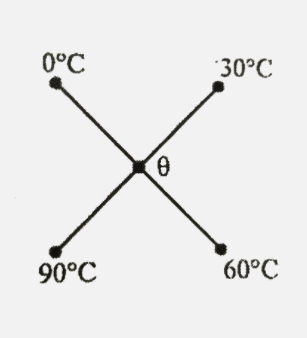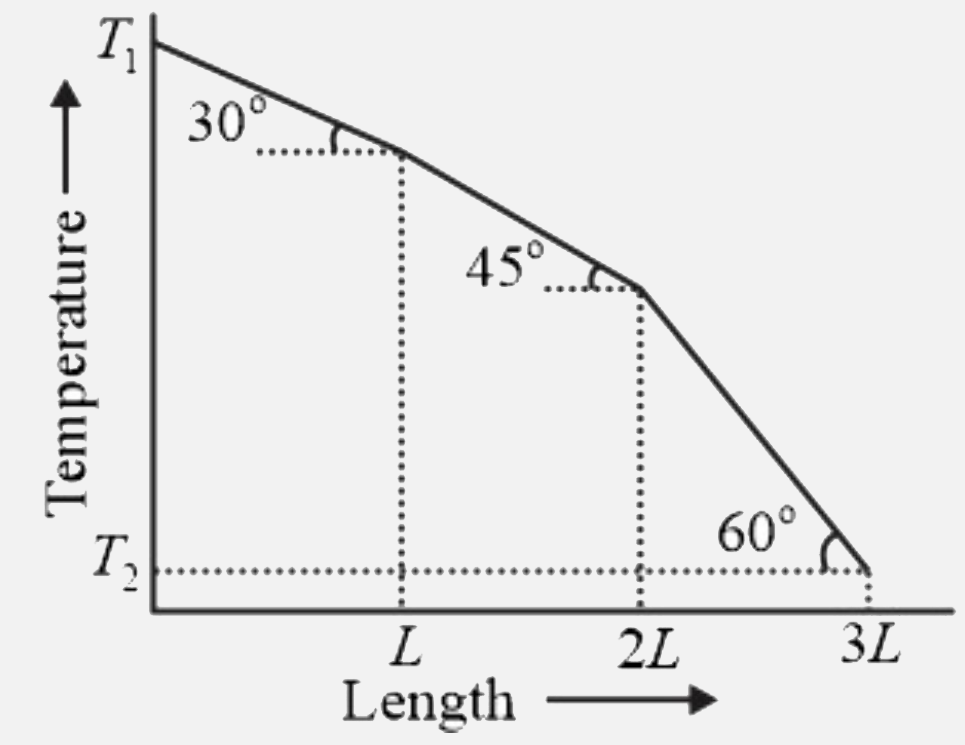A composite rod is made by joining a copper rod, end to end, with a second rod of different material but of the same area of cross section. At 25∘C, the composite rod is 1m long and the copper rod is 30cm long. At 125∘C the length of the composite rod increases by 1.91mm. When the composite rod is prevented from expanding by holding it between two rigid walls, it is found that the constituent rods have remained unchanged in length inspite of rise of temperature. Find young's modulus and the coefficient of linear expansion of the second rod (Y of copper =1.3×1010N/m2 and a of copper =17×10−6/K).
The correct Answer is:2
To solve the problem step by step, we will follow the given information and apply the relevant formulas.
Step 1: Understand the given data
- Length of the composite rod at 25∘C: L=1m
- Length of the copper rod: Lc=30cm=0.3m
- Length of the second rod: Lx=L−Lc=1−0.3=0.7m
- Change in temperature: ΔT=125∘C−25∘C=100K
- Total change in length of the composite rod: ΔL=1.91mm=1.91×10−3m
- Coefficient of linear expansion of copper: αc=17×10−6K−1
- Young's modulus of copper: Yc=1.3×1010N/m2
Step 2: Calculate the change in length of the copper rod
Using the formula for linear expansion:
ΔLc=αc⋅Lc⋅ΔT
Substituting the values:
ΔLc=17×10−6⋅0.3⋅100=5.1×10−4m
Step 3: Set up the equation for the total change in length
The total change in length of the composite rod is the sum of the changes in length of both rods:
ΔL=ΔLc+ΔLx
Where ΔLx is the change in length of the second rod. Thus,
1.91×10−3=5.1×10−4+ΔLx
Solving for ΔLx:
ΔLx=1.91×10−3−5.1×10−4=1.4×10−3m
Step 4: Calculate the coefficient of linear expansion of the second rod
Using the formula for linear expansion for the second rod:
ΔLx=αx⋅Lx⋅ΔT
Substituting the known values:
1.4×10−3=αx⋅0.7⋅100
Solving for αx:
αx=1.4×10−30.7⋅100=2×10−5K−1
Step 5: Calculate the strain in the copper rod
The strain in the copper rod can be calculated as:
Strain=ΔLcLc=5.1×10−40.3=1.7×10−3
Step 6: Calculate the stress in the copper rod
Using Young's modulus:
Yc=StressStrain⟹Stress=Yc⋅Strain
Substituting the values:
Stress=1.3×1010⋅1.7×10−3=2.21×107N/m2
Step 7: Calculate the strain in the second rod
Using the formula for strain:
Strain=ΔLxLx=1.4×10−30.7=2×10−3
Step 8: Calculate Young's modulus of the second rod
Using the same stress for both rods:
Yx=StressStrain⟹Yx=2.21×1072×10−3=1.105×1010N/m2
Final Results
- Coefficient of linear expansion of the second rod: αx=2×10−5K−1
- Young's modulus of the second rod: Yx=1.105×1010N/m2
- Length of the composite rod at 25∘C: L=1m
- Length of the copper rod: Lc=30cm=0.3m
- Length of the second rod: Lx=L−Lc=1−0.3=0.7m
- Change in temperature: ΔT=125∘C−25∘C=100K
- Total change in length of the composite rod: ΔL=1.91mm=1.91×10−3m
- Coefficient of linear expansion of copper: αc=17×10−6K−1
- Young's modulus of copper: Yc=1.3×1010N/m2
Using the formula for linear expansion:
ΔLc=αc⋅Lc⋅ΔT
Substituting the values:
ΔLc=17×10−6⋅0.3⋅100=5.1×10−4m
The total change in length of the composite rod is the sum of the changes in length of both rods:
ΔL=ΔLc+ΔLx
Where ΔLx is the change in length of the second rod. Thus,
1.91×10−3=5.1×10−4+ΔLx
Solving for ΔLx:
ΔLx=1.91×10−3−5.1×10−4=1.4×10−3m
Using the formula for linear expansion for the second rod:
ΔLx=αx⋅Lx⋅ΔT
Substituting the known values:
1.4×10−3=αx⋅0.7⋅100
Solving for αx:
αx=1.4×10−30.7⋅100=2×10−5K−1
The strain in the copper rod can be calculated as:
Strain=ΔLcLc=5.1×10−40.3=1.7×10−3
Using Young's modulus:
Yc=StressStrain⟹Stress=Yc⋅Strain
Substituting the values:
Stress=1.3×1010⋅1.7×10−3=2.21×107N/m2
Using the formula for strain:
Strain=ΔLxLx=1.4×10−30.7=2×10−3
Using the same stress for both rods:
Yx=StressStrain⟹Yx=2.21×1072×10−3=1.105×1010N/m2
- Coefficient of linear expansion of the second rod: αx=2×10−5K−1
- Young's modulus of the second rod: Yx=1.105×1010N/m2
Topper's Solved these Questions
- PROPERTIES OF MATTERBOOK - VMC MODULES ENGLISHCHAPTER - PROPERTIES OF MATTEREXERCISE - Level -2
50 Videos
- PROPERTIES OF MATTERBOOK - VMC MODULES ENGLISHCHAPTER - PROPERTIES OF MATTEREXERCISE - JEE Main (Archive) Level - 1
48 Videos
- PROPERTIES OF MATTERBOOK - VMC MODULES ENGLISHCHAPTER - PROPERTIES OF MATTEREXERCISE - JEE Advanced (Archive) Level - 2 (MATRIX MATCH TYPE)
1 Videos
- MOVING CHARGES & MAGNETISM BOOK - VMC MODULES ENGLISHCHAPTER - MOVING CHARGES & MAGNETISM EXERCISE - IN-CHAPTER EXERCISE-K
10 Videos
- QUIZBOOK - VMC MODULES ENGLISHCHAPTER - QUIZEXERCISE - PHYSICS
30 Videos
Similar Questions
A composite rod is made by joining a copper rod, end to end, with a second rod of different material but of the same area of cross section. At 25∘C, the composite rod is 1m long and the copper rod is 30cm long. At 125∘C the length of the composte rod increases by 1.91mm. When the composite rod is prevented from expanding by bolding it between two rigid walls, it is found that the constituent reds have remained unchanged in length in splite of rise of temperature. Find yong's modulus and the coefficient of linear expansion of the second red (Y of copper =1.3×1010N/m2 and a of copper =17×10−6/K).
View SolutionTwo rods of equal cross sections, one of copper and the other of steel, are joined to form a composite rod of length 2.0 m at 20∘C, the length of the copper rod is 0.5 m. When the temperature is raised to 120∘C, the length of composite rod increases to 2.002m. If the composite rod is fixed between two rigid walls and thus not allowed to expand, it is found that the lengths of the component rods also do not change with increase in temperature. Calculate Young's moulus of steel. (The coefficient of linear expansion of copper, αc=1.6×10−5∘C and Young's modulus of copper is 1.3×1013N/m2).
View SolutionThe ratio of thermal conductivity of two rods of different material is 5:4. The two rods of same area of cross-section and same thermal resistance will have the lengths in the ratio
View SolutionThe end of two rods of different materials with their thermal conductivities, area of cross-section and lengths all in the ratio 1:2 are maintained at the same temperature difference. If the rate of flow of heat in the first rod is 4cal/s. Then, in the second rod rate of heat flow in cal/s will be
View Solutionon heating a cylindrical metallic rod, its length increases by 2% . Then area of cross section of rod will
View SolutionA composite rod consists of a steel rod of length 25cm and area 2A and a copper rod of length 50cm and area A. The composite rod is subjected to an axial load F. If the Young's moduli of steel and copper are in the ratio 2:1 then
View SolutionA semicircular rods is joined at its end to a straight rod of the same material and the same cross-sectional area. The straight rod forms a diameter of the other rod. The junctions are maintained at different temperatures. Find the ratio of the heat transferred through a cross section of the straight rod in a given time.
View SolutionThe temperature gradient in a rod of 0.5m length is 80∘C/m. It the temperature of hotter end of the rod is 30∘C, then the temperature of the cooler end is
View SolutionFour rods of same material and having the same cross section and length have been joined, as shown. The temperature of the junction of four rods will be :

View SolutionThree rods of the same length and the same area of the cross-section are joined. The temperature of two ends one T1 and T2 as shown in the figure.
 As we move along the rod the variation of temperature are as shown in the following [Rods are insulated from the surrounding except at the faces]
As we move along the rod the variation of temperature are as shown in the following [Rods are insulated from the surrounding except at the faces]

View Solution
